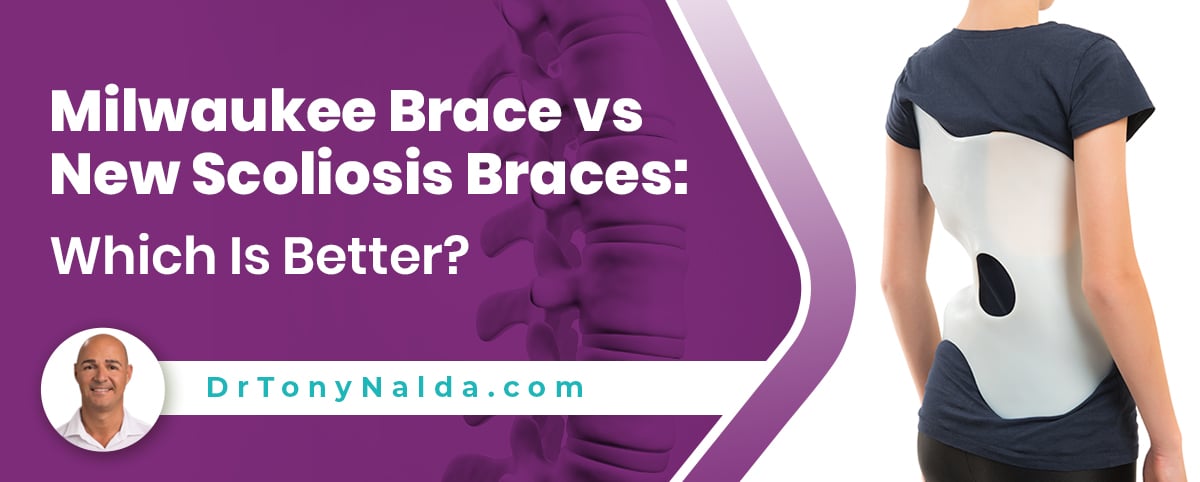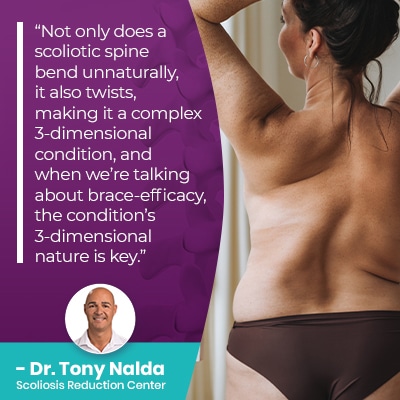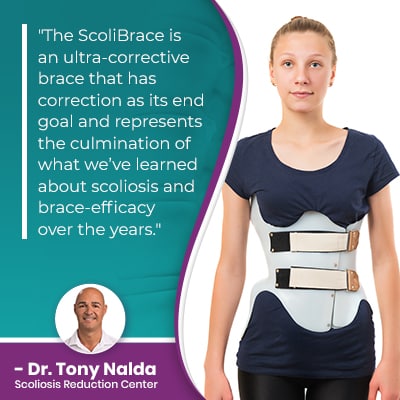Milwaukee Brace vs New Scoliosis Braces: Which Is Better?

Treatment goals shape the design of treatment plans, and when it comes to traditional treatment and traditional braces like the Milwaukee, the goal is to prevent progression; the goal of modern conservative treatment and modern braces like the ScoliBrace is to achieve actual corrective results.
Not only are there different scoliosis treatment approaches, there are also different types of scoliosis braces, and not all offer the same potential outcomes. Traditional braces like the Milwaukee have a number of shortcomings, while modern corrective bracing addresses those shortfalls.
Before getting to the specific differences between the Milwaukee brace and modern corrective scoliosis braces, let’s start by defining scoliosis and the different treatment approaches.
Table of Contents
What is Scoliosis?
Scoliosis is the development of an unnatural sideways spinal curve, and while there are a number of spinal conditions that involve a loss of its healthy curves, what sets scoliosis apart is its rotational component.
 Not only does a scoliotic spine bend unnaturally, it also twists, making it a complex 3-dimensional condition, and when we’re talking about brace-efficacy, the condition’s 3-dimensional nature is key.
Not only does a scoliotic spine bend unnaturally, it also twists, making it a complex 3-dimensional condition, and when we’re talking about brace-efficacy, the condition’s 3-dimensional nature is key.
Scoliosis is also a progressive condition, meaning it’s virtually guaranteed to get worse over time, and ranging from mild to moderate and severe to very severe, where a scoliosis is when it’s diagnosed isn’t always where it will stay; only proactive treatment can work towards counteracting the condition’s progressive nature.
As scoliosis progresses, the size of the unnatural spinal curve is increasing, and this means the condition’s uneven forces are also increasing, as are their effects.
As a progressive condition, how a diagnosis is responded to is key because different treatment approaches offer different potential outcomes, and this is reflected in the types of treatment applied, including traditional versus modern scoliosis braces.
So let’s talk about the two main scoliosis treatment approaches, traditional and conservative, as each has a different treatment goal and favors a different type of scoliosis brace.
Traditional Scoliosis Treatment and the Milwaukee Brace
The traditional approach to treating scoliosis involves watching and waiting, traditional bracing, and commonly funnels patients towards spinal fusion surgery.
Traditional treatment has the goal of stopping progression, and this isn’t the same as working towards achieving corrective results.
As there is no strategy for treating mild scoliosis in traditional treatment, patients are commonly told to watch and wait for signs of continued progression, but remember, as a progressive condition, it’s virtually guaranteed to get worse at some point, so this, to me, is wasting valuable treatment time.
The only type of treatment applied under traditional care, prior to a surgical recommendation, is traditional bracing that’s associated with a number of shortfalls.
Milwaukee Brace
The Milwaukee brace, for example, is a CTLSO (Cervico-Thoraco-Lumbo-Sacral) brace that’s most commonly used in the treatment of thoracic scoliosis (middle/upper back).
The design of the Milwaukee is cumbersome as it extends from the neck to the pelvis; a neck ring and pelvic girdle are connected by metal bars that extend the length of the torso, and this helps keep the head centered over the pelvis.
The Milwaukee, and similar traditional braces, use a type of three-point pressure system that squeezes the spine unnaturally to stop progression and force it into a corrective position, but over time, this can actually weaken the spine.
The main issues with traditional braces like the Milwaukee are that it doesn’t address the condition’s 3-dimensional nature, ignoring its rotational component, so its efficacy is limited.
In addition, in order for any scoliosis brace to be effective, it has to be worn exactly as prescribed, and as the Milwaukee has such a cumbersome design, compliance becomes problematic.
The squeezing of the spine can also cause breathing problems, increased postural deviation, pain, activity restrictions, overheating, skin chafing, the inability to engage in flexible movements, and negative self-image.
Considering the age group that’s most commonly affected by scoliosis, adolescents between the ages of 10 and 18, this is the age group most likely to have issues with wearing a cumbersome scoliosis brace for anywhere up to 23 hours a day.
Fortunately, there are other brace options for patients to consider, like the ultra-corrective ScoliBrace favored in conservative treatment.
Conservative Treatment and the ScoliBrace
Here at the Scoliosis Reduction Center, I treat patients with a modern conservative chiropractic-centered treatment approach that has the ultimate goal of achieving corrective results.
Correcting a scoliosis means impacting it on a structural level; as a structural spinal condition, scoliosis has to, first and foremost, be impacted on a structural level.
Corrective results means achieving a curvature reduction, but there are also other key aspects of treatment such as increasing core strength, corrective bracing, and rehabilitation.
Conservative treatment is proactive by starting treatment as close to the time of diagnosis as possible.
While there are never treatment guarantees, it’s simpler to treat scoliosis while mild, before significant progression has occurred making the spine more rigid, less responsive to treatment, and making certain therapeutic exercises that are key to treatment difficult for patients to perform; this is the benefit of starting treatment while a condition is still mild.
I offer patients a non-surgical treatment alternative because even when successful, spinal fusion surgery is a costly, lengthy, and invasive procedure that can cost the spine in terms of its overall health, strength, and function.
Conservative treatment works towards reducing the size of the unnatural spinal curve and restoring as much of the spine’s natural and healthy curves as possible; I feel this gives my patients the best quality of life.
I combine multiple different types of condition-specific treatment disciplines so conditions can be impacted on every level: chiropractic care, physical therapy, corrective bracing, and rehabilitation.
ScoliBrace
 The ScoliBrace is an ultra-corrective brace that has correction as its end goal and represents the culmination of what we’ve learned about scoliosis and brace-efficacy over the years.
The ScoliBrace is an ultra-corrective brace that has correction as its end goal and represents the culmination of what we’ve learned about scoliosis and brace-efficacy over the years.
The ScoliBrace addresses many of the shortcomings associated with traditional braces by:
- Addressing scoliosis as a 3-dimensional condition
- Pushing the spine into a corrective position, instead of squeezing it
- Using state-of-the-art scanning and imaging technology to ensure each brace is customized to suit a patient’s body/curvature type
- Improving postural deviation
- Making the brace easy to open and close at the front
- Having different pattern choices for further individual customization
- Better rates of compliance
While no brace on its own would be enough to correct a scoliosis, when a corrective brace is integrated into a proactive treatment plan that combines multiple treatment disciplines, it can help augment corrective results by pushing the spine into a corrective position.
Braces can be particularly effective on growing spines so is a common facet of treatment in the condtion’s most prevalent type: adolescent idiopathic scoliosis.
Conclusion
After receiving a diagnosis of scoliosis, the most important decision to make is how to treat it, and this is because as a progressive condition, scoliosis is incurable, but it can be highly treatable.
While there are never treatment guarantees, conditions that are diagnosed early and responded to with proactive treatment are more likely to respond favorably, and conditions that are left untreated are likely to get worse over time, making them more complex to treat.
The two main scoliosis treatment approaches for patients to choose between are traditional and conservative; the former favors traditional braces like the Milwaukee, while the latter prefers the use of a modern corrective brace like the ScoliBrace.
The Milwaukee, and similar traditional scoliosis braces, are limited in their efficacy for a number of reasons, but mainly because they ignore the condition’s rotational component, only addressing it as a 2-dimensional condition, when, in fact, it is a 3-dimensional condition.
The Milwaukee also squeezes the spine unnaturally, and as a scoliotic spine is already exposed to uneven forces that can impact its overall health, strength, and function, it needs to be strengthened, not weakened further.
In addition, because of the squeezing method, traditional braces are known to increase postural deviation, rather than improve it, and they are also associated with breathing problems, compliance issues, activity restrictions, chafed skin, overheating, and more.
Modern corrective braces like the ScioliBrace address the condition’s true 3-dimensional nature and do so by pushing the spine into a corrective position, rather than squeezing it, as we now know that squeezing the spine can weaken it over time.
In addition, the ScoliBrace is customized to suit each patient's body type and curvature type so they are less cumbersome to wear, and this addresses issues of compliance.
Here at the Scoliosis Reduction Center, I favor a modern ScoliBrace to meet my patients’ bracing needs as it’s aligned with the end goal of a conservative treatment approach: correcting a scoliosis on a structural level.
Dr. Tony Nalda
DOCTOR OF CHIROPRACTIC
After receiving an undergraduate degree in psychology and his Doctorate of Chiropractic from Life University, Dr. Nalda settled in Celebration, Florida and proceeded to build one of Central Florida’s most successful chiropractic clinics.
His experience with patients suffering from scoliosis, and the confusion and frustration they faced, led him to seek a specialty in scoliosis care. In 2006 he completed his Intensive Care Certification from CLEAR Institute, a leading scoliosis educational and certification center.
About Dr. Tony Nalda
 Ready to explore scoliosis treatment? Contact Us Now
Ready to explore scoliosis treatment? Contact Us Now





